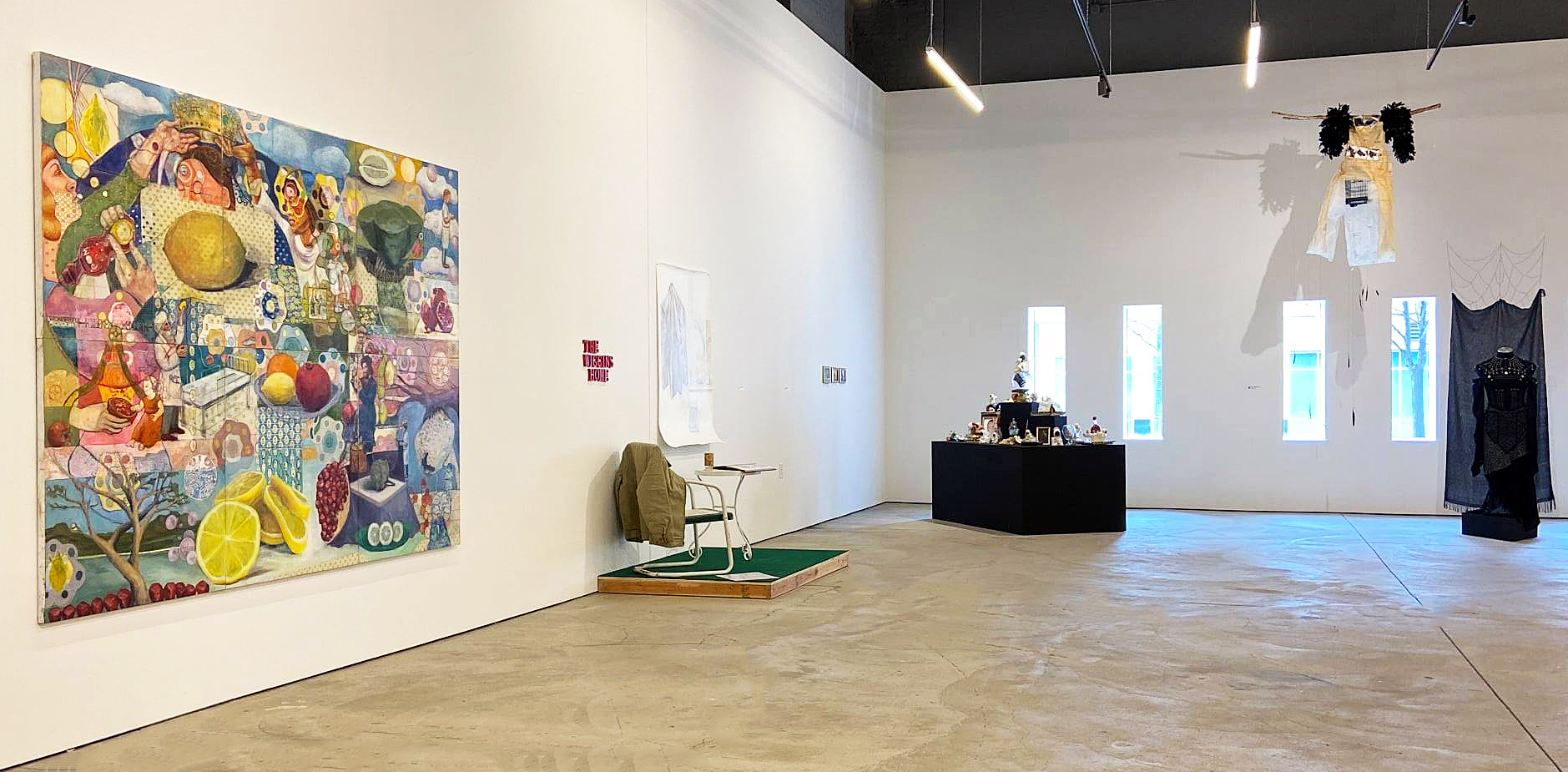
Install image, Dual Vision, MOCAD, 202, All images courtesy of K.A. Letts
It’s March 2021, and we’re beginning to sense the coming of spring and an end to our seemingly endless COVID winter. If crowded bars and restaurants are still out of the question, we can at least look forward to pants with waistbands and the occasional coffee at Starbucks. The curators of Dual Vision at MOCAD appear to be sensing it too. Curator Jova Lynne, assisted by Maceo Keeling and advised by Kathryn Brackett Luchs, Ed Fraga and Robert Sestok, have assembled 40 Detroit artists, working in pairs, to showcase the personal interactions we have all been missing. Some of Detroit’s best known and most accomplished creatives–along with a few newcomers– are celebrating at least the prospect of a return to normal.
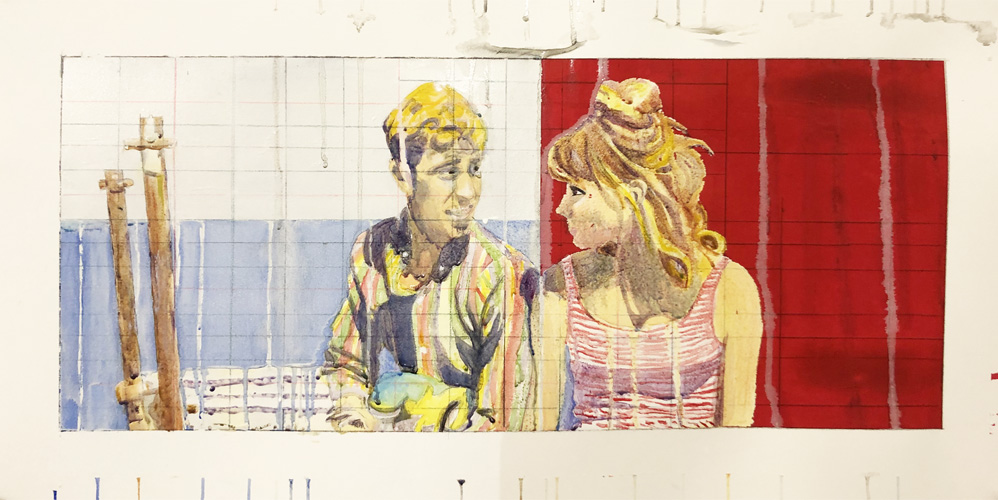
Betty Brownlee + Cristin Richard, A Critique of Jean-Luc Goddard, 2021, mixed media detail.
Dual Vision, on view at MOCAD until August 8, 2021, is an all-of-the-above kind of exhibition that allows plenty of scope for artists working in a variety of media–video, painting, sculpture, sound, photography, fiber, printmaking. In the spirit of re-connecting, I met my friend and fellow arts writer Mariwyn Curtin at the gallery. Our visit provided us with an opportunity to practice the cultural interaction that will soon be part of our lives again. We hope.
Mariwyn and I noticed immediately the preponderance of installation among the entries. This makes sense; the installation form allows maximum individual expression for each artist, while demonstrating–as if we didn’t know it already–that a collaborative artwork can be more than the sum of its parts.
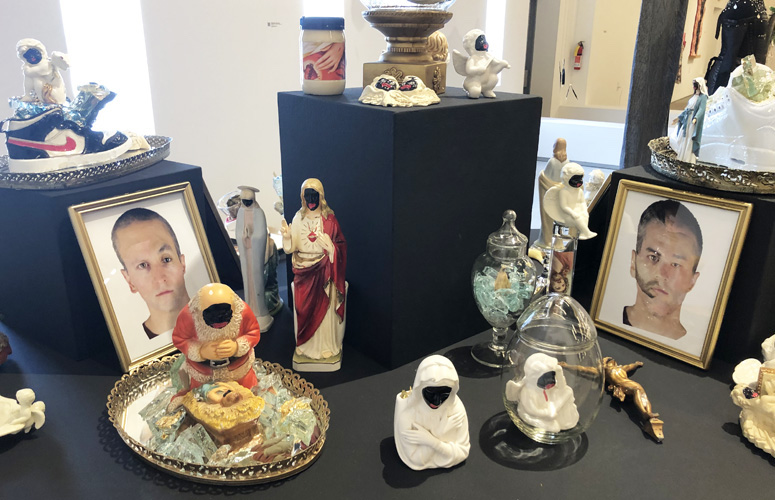
Tony Rave + Tylonn J. Sawyer, Family Matter Episode 3 x Black and Blue: Field Notes, 2021, mixed media installation detail
A number of ofrenda-adjacent collections of objects and images included strong spiritual themes, while others featured ripped-from-the-headlines immediacy. Tony Rave and Tylonn J. Sawyer’s installation, Family Matter Episode 3 x Black & Blue: Field Notes managed to combine both elements. The altar-like installation presented a profusion of Rave’s saccharine white, ready-made ceramic figurines, mostly devotional in nature, their faces obscured by painted-on blackface. They seemed–to me–to illustrate the artist’s bleak observation that Blackness is itself a social construct perpetrated by White culture. The theme was amplified by Sawyer’s companion pieces, family portrait-sized composite pictures of the 4 officers implicated in the death of George Floyd that provided a bitter corollary comment on the provisional nature of racial identity.
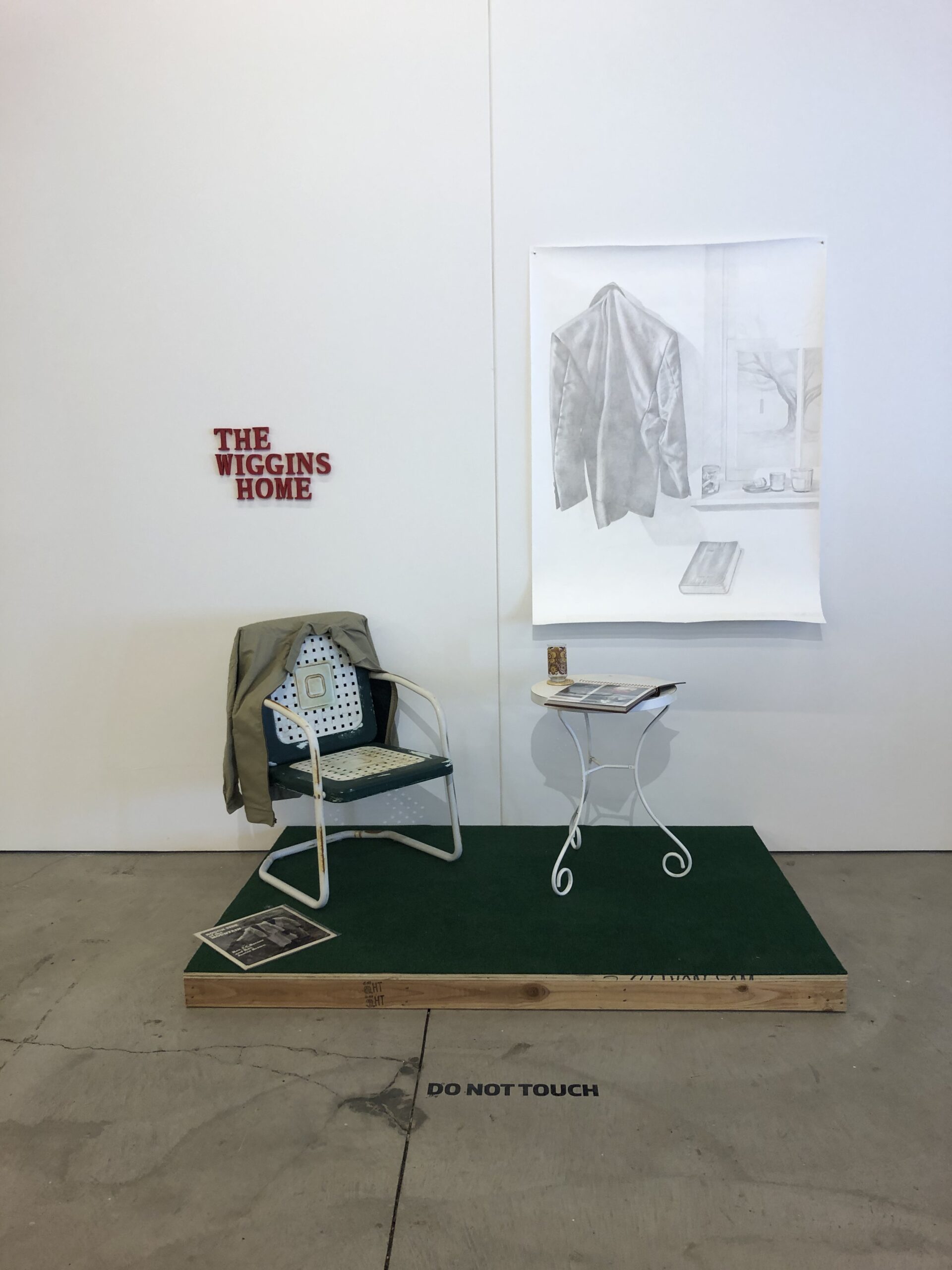
Rashaun Rucker + Mario Moore, Big Ma’s Porch (A Black Sanctuary) 2021, mixed media installation
Some much-needed psychological relief from the rawness of the Rave/Sawyer installation was provided by the nearby collaboration of Mario Moore and Rashaun Rucker. Big Ma’s Porch (A Black Sanctuary) conjures the artist’s wistful childhood recollections of his great grandparents’ front porch, a place of love and safety and tall tales, the mood of warm memory reinforced by Moore’s lovely silverpoint drawing.
My gallery companion brought her own distinctive sensibility to Dual Vision; Mariwyn responded to a couple of collaborations that I perhaps lacked the background to appreciate. She particularly enjoyed A Critique of Jean-Luc Goddard by Betty Brownlee and Cristin Richard. She observed, “The skin-like translucent paper banners with French words on them was intriguing. Getting to the wall of images behind the banners was a little like passing through a section of forest with tall white trees. When I saw the wall of paintings, I thought immediately of Cindy Sherman’s Film Stills series. Once I made it through to read the label on the wall, it was rewarding to realize that [the collaboration] did indeed feature painted stills from films by Goddard.”
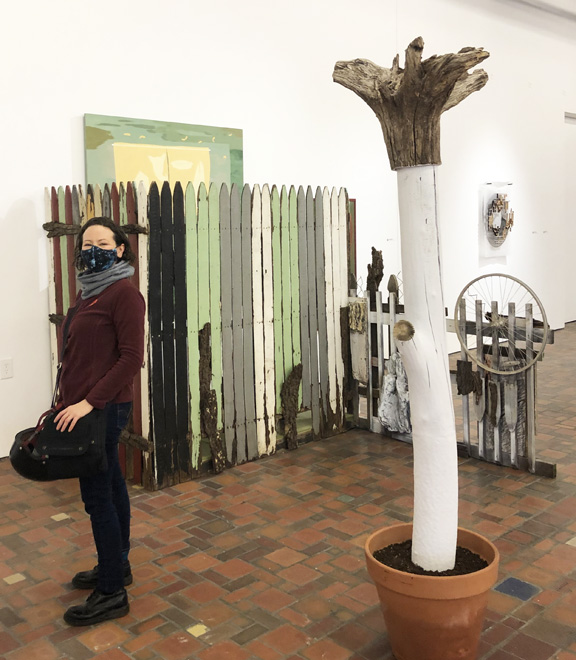
Mariwyn Curtin standing next to In Front of My Backyard by Julia Callis + Josh Kochis, 2021, acrylic, graphite, string on panel, mixed media installation.
The collection of smallish paintings by Nancy Mitchnick and John Corbin on the subject of the periodic table seemed a bit scattershot to me, but Mariwyn found something to like in the looseness of their improvisatory approach. She commented, “I thought it was interesting that the collaboration … was called Untitled when there is such a heavily researched background to the work…The treatment of each element captures the wave state of atoms more so than the Bohr diagrams seen in chemistry textbooks that look like mini solar systems. Each painting or cardboard mosaic seemed like a portrait of the doorway between particle and wave state.”
In the center of the gallery, images in Tyanna Buie and Chelsea A. Flowers’s video collage Call and Response prompted a visceral reaction. Adjacent television monitors engage in cacophonous conversation with each other and deftly capture the drinking-from-a-firehose quality of current events. The fragmented clips, in which Buie and Flowers use off-the-shelf photographic apps to superimpose their faces onto pop culture and political figures to pointed comic effect, illustrate the extent to which our experience of events is colored by our racial identity in these polarized times.
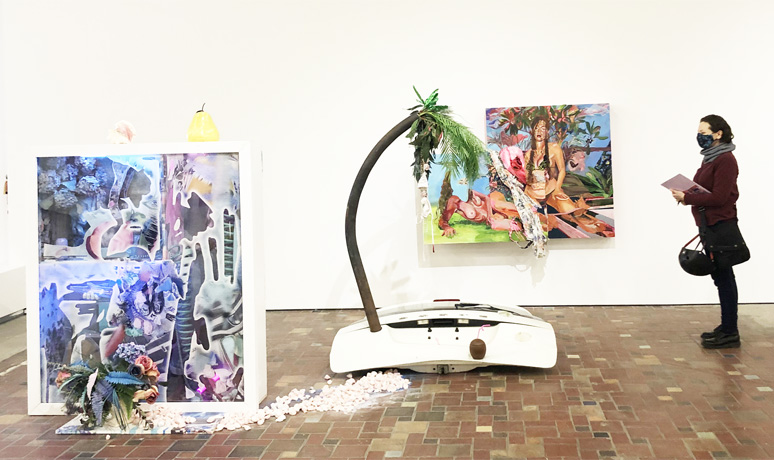
Gisela McDaniel + Martha Mysko, Self Portraits In: Self portraiture in surrounding, in landscape, in DNA, in objects, in material, in eyes, in stories, in images, in the present, in the past, in plastic, in the familiar, 2021, Mixed media installation
Gisela McDaniel and Martha Mysko‘s mixed media installation wins the prize for best title: Self Portraits In: Self portraiture in surrounding, in landscape, in DNA, in objects, in material, in eyes, in stories, in images, in the present, in the past, in plastic, in the familiar. This maximalist collection of fuschia and turquoise figurative and abstract paintings next to a bedraggled palm tree, near a pina colada perched on a wrecked car hood, manages to suggest both a tropical getaway and a post-apocalyptic scene of environmental destruction. I felt a wave of nostalgia for the beach vacation none of us took this year, along with a distinct urge to get my towel and lie down on the radioactive sand.
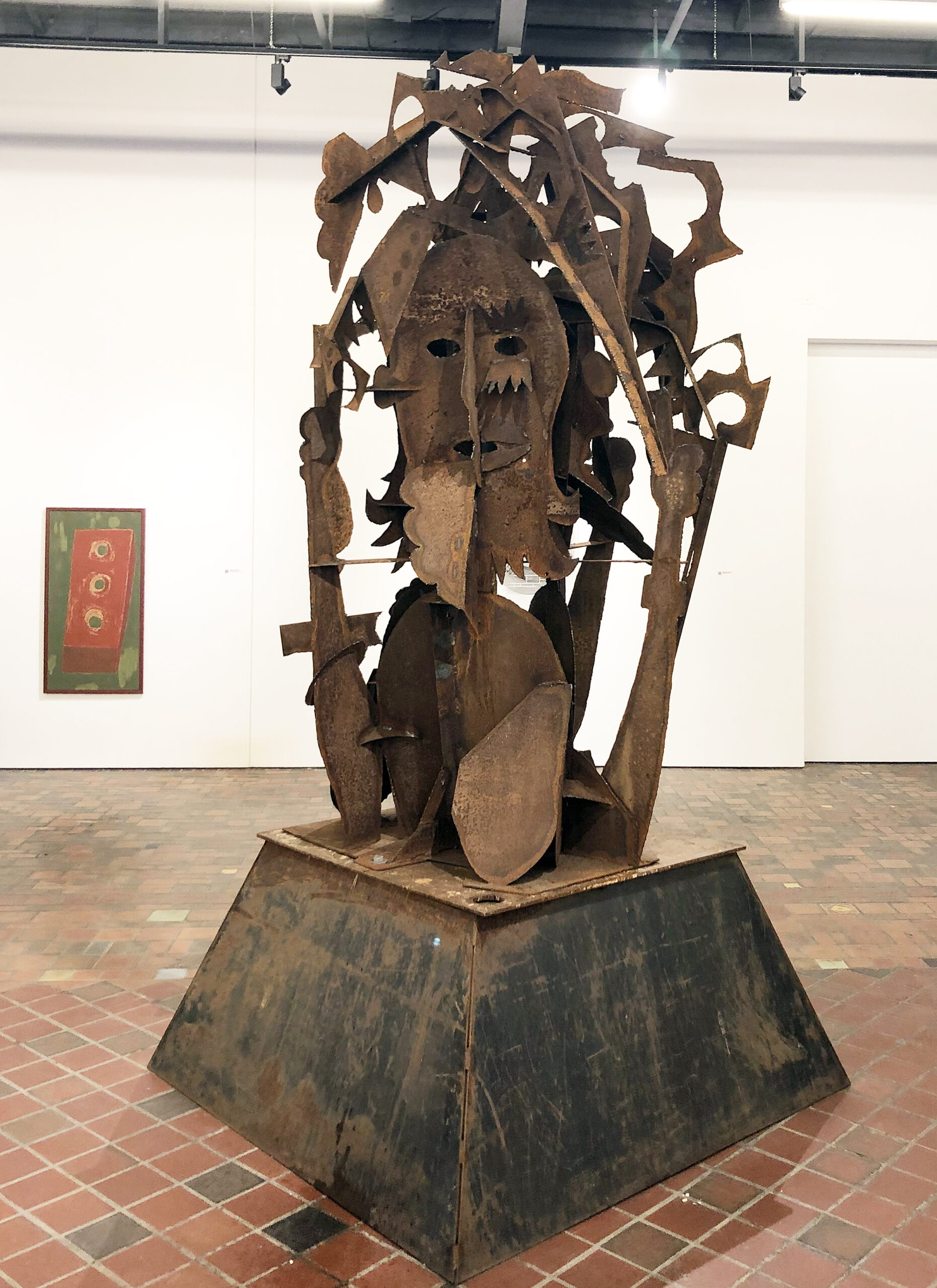
Robert Sestok + Kurt Novak, Forgotten Networks, 2020, Welded steel
In the center of the gallery, Robert Sestok and Kurt Novak contributed visual ballast to Dual Vision with their terrific steel assemblage Forgotten Networks. The monumental sculpture, which combines Novak’s humorous accessibility with Sestok’s formal elegance, provides a strong focal point for the exhibit around which the other artists’ work seems to revolve.

Michael Luchs, Moth (Jade), 2020, Woodcut, collagraph, sumi ink on glassine paper on canvas
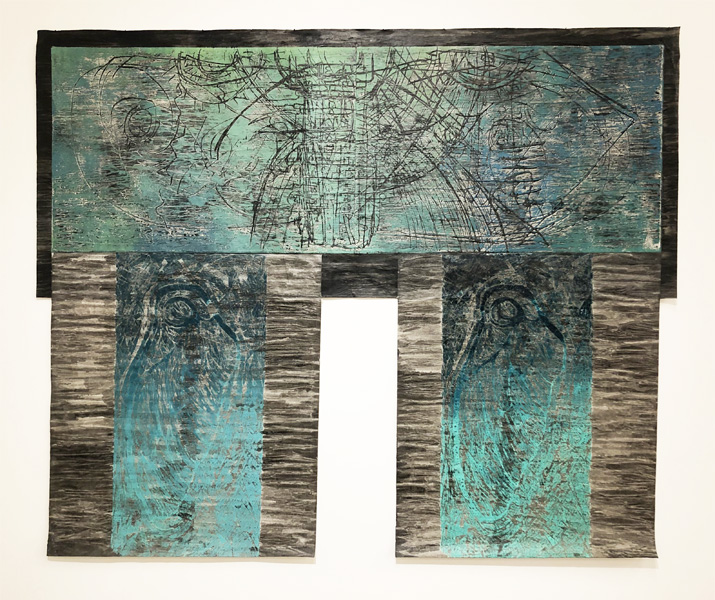
Kathryn Brackett Luchs, Moth (Pink), 2020-21, Woodcut, sumi ink, on glassine paper on canva
Both Mariwyn and I enjoyed In Front of my Back Yard by Julia Callis and Josh Kochis, though her observations were better articulated than mine. She: “The installation of the distressed wood fence really gave the sense of peeking into a window from the outside yard and made me feel a bit like a voyeur.” Me: “Wow. I love those flat sea green, black and silvery gray colors.” The hues and textures of the wooden and found objects in Callis and Kochis’s environment accord well with the handsome pair of matching kimono-like wall hangings by Kathryn Brackett Luchs and Michael Luchs, installed on an adjacent gallery wall. The tissue-like glassine paper and the jittery marks of the sumi ink of Moth (Jade) and Moth (Pink) bring to mind the silence of moths’ wings as they pursue their life cycle through day and night and space and time.
My visit to Dual Vision with Mariwyn reminded me of how much I’ve missed social interaction and good conversation about art during the pandemic. There was a lot to look at and respond to–more than anyone could see and comment on in only one visit. Other viewers will respond to some of the work that we haven’t mentioned, and I suppose that on another trip to MOCAD my friend and I might see things we missed on our first pass. Dual Vision has presented us with an invitation to celebrate our resilient and diverse Detroit art community, to reconnect, re-engage and restart our cultural conversation. I suggest you schedule a visit to form your own opinion. Bring a friend.
Dual Vision Participating Artists:
Robert Sestok & Kurt Novak, Jim Chatelain & Steve Foust, Kathryn Brackett Luchs & Michael Luchs, Joyce Brienza & Deborah Sukenic, Simone DeSousa & Tim Van Laar, Nancy Mitchnick & John Corbin, Carlo Vitale & Ed Fraga, Nicole Macdonald & Carl Wilson, Betty Brownlee & Cristin Richard, John Egner & Amelia Currier, Gisela McDaniel & Martha Mysko, Tony Rave & Tylonn Sawyer, Rashaun Rucker & Mario Moore, Tyanna Buie & Cheris Morris, Nour Ballout & Cyrah Dardas, Bree Gant & Cherise Morris, Sabrina Nelson & Levon Kafafian, Sterling Toles & Nate Mullen, Adam Lee Miller & Nicola Nuperus.
MOCAD Dual Vision through August 8, 2021
